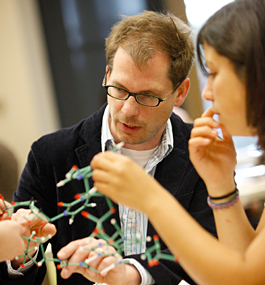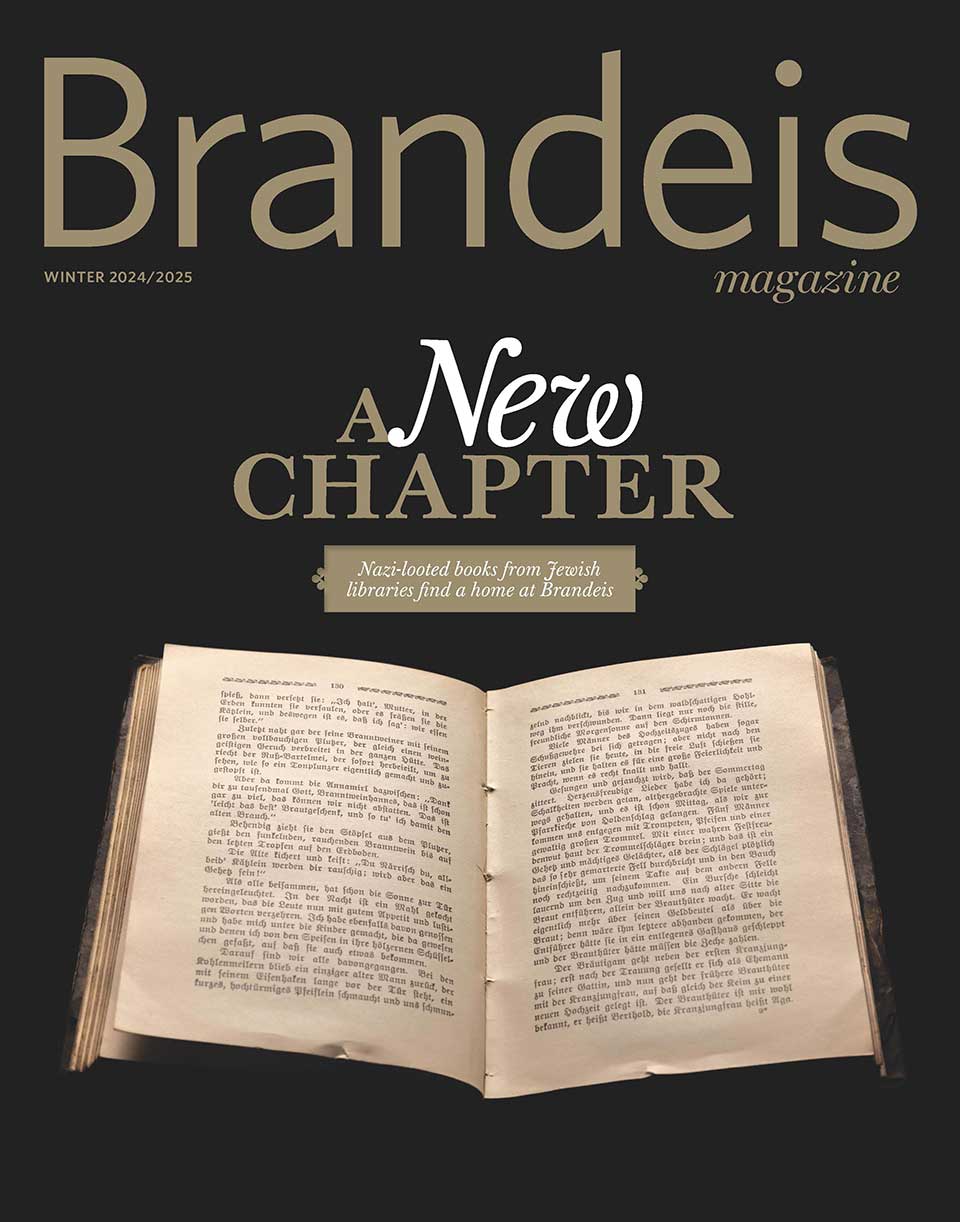Shaking the Family Tree
A 21st-century biochemist puts meat on the bones of Charles Darwin’s 150-year-old discoveries.

Mike Lovett
Biochemist Douglas Theobald discusses the evolution of molecular structure with doctoral student Ashley Lajoie.
by Laura Gardner
Like many scientists, Douglas Theobald is prone to cultivating a single patch of scientific ground for long stretches of time. For more than a decade, the assistant professor of biochemistry has been exploring the lush landscape of Charles Darwin’s theory of evolution, an adjunct to his main focus on the evolution of the molecular structure of proteins. It is undeniably well-trodden terrain, with legions of notable minds preceding him on the road to scientific affirmation of the theory of universal common ancestry (UCA) proposed by Darwin in his groundbreaking book “On The Origin of Species.”
“All the organic beings which have ever lived on this earth have descended from some one primordial form,” the English naturalist postulated in his 1859 book, initially generating shock and awe and eventually providing the foundation of modern biology. This idea that all living organisms, from champagne yeast to ladybugs, from oak trees to humans, are distantly related through a shared genetic heritage — what we now call the universal genetic code — has been steadily fortified since Darwin’s time through transitional fossils, as well as in fundamental biological similarities at the molecular level.
The Ascent of Evolution
But if evolution — based on UCA and natural selection as the mechanism of biological adaptation — seems the scientific equivalent of “settled law,” Theobald has given the 19th-century theory some 21st-century ammunition. Earlier this year, the 40-year-old published the first formal, large-scale quantitative test of Darwin’s theory of UCA in the prestigious research journal Nature. The article generated considerable scientific and media interest, as well as the usual frothy denigrations from the evolution-denier camp.
Theobald describes it as a “short, fun study.” But it was also an ambitious undertaking, given that he set out to establish genetic kinship among all life forms going “back across the eons to the emergence of life itself,” as Scientific American put it.
Using probability theory and harnessing powerful computational tools — four Linux computers churned for months at a time — Theobald determined the likelihood that all life evolved from a single common ancestor to be 1 in 10 to the 2,860th power (that’s a 1 followed by 2,860 zeros) more likely than the next most likely scenario of even two common ancestors. He also included a shout-out in his study to creationists. The odds of humans originating independently of all other life forms he determined to be 10 to the 6,000th power (10 followed by 5,999 zeros) to one.
But really, why even bother scaling a statistical Everest when mountains of qualitative evidence, DNA and otherwise, already inescapably support UCA? To answer that question, it helps to know a little about the personal evolution of the Brandeis scientist. The Nature study is the logical outcome of Theobald’s fascination since boyhood with grand scientific ideas. Theobald was one of those kids who actually read the Encyclopedia Britannica from cover to cover. But he didn’t stop there.
The Beagle and the Lab Bench
“I remember being 7 or 8 years old and reading through my dad’s college biology text book on evolution and thinking, ‘this makes a lot of sense,’” says Theobald. His parents, conservative Christians from the Midwest, didn’t share his perspective on evolution or his interest in it. Still, they enthusiastically encouraged the young Theobald to pursue science passionately. By fourth grade, Theobald says, he had essentially taught himself Einstein’s theory of relativity, minus some of the higher mathematics.
page 2 of 2
Describing his early scientific approach in a mild Tennessee twang — he attended secondary school in Johnson City and graduated from the University of Tennessee — Theobald recalls, “As a kid I had a pretty analytical mind; I wanted to step back and pretend I didn’t know anything, and then consider the problem in front of me systematically.”
Theobald used the same broadly analytical but highly creative approach in this latest evolutionary research, says Brandeis biochemist and Howard Hughes Medical Investigator Chris Miller. To approach evolutionary theory with verve and freshness is a tall order considering it’s an area largely beyond substantive scientific controversy. As an accompanying editorial in Nature noted, “Common ancestry is the default view in science.”
Nevertheless, Darwin’s grand theory remains of interest to scientists and the public alike, and not only because last year was the 150th anniversary of the publication of his seminal book. The genomic and computational tools of the modern biologist represent a huge leap forward — perhaps something akin to going from living in trees to walking upright. Museum exhibitions, scientific conferences, scholarly articles and lectures reflect a hunger to explore the mounting evidence and ramifications of UCA. And of course scientists love to test theories.
Putting Evolution to the Test
Theobald is no exception. “Doug is a deep and wide-ranging intellectual whose presence is enriching the department,” Miller says. But Theobald seemed a little embarrassed at the beginning of this project because “everyone knows evolution is true,” says Miller. It began almost on a lark, as “a cutesy project,” confesses Theobald. But over several years, as he thought about how to devise the test and discussed ideas at conferences around the world, top evolutionary biologists weighed in with advice and encouragement.
Like everything else on the planet, the project evolved. Miller says the sheer ambition of it was remarkable. “Nobody had done this kind of calculation before because it involves sophisticated mathematics; nobody had undertaken a scholarly, formal test of evolution,” he says. Theobald took on one of the fundamental ideas of biology and applied an equally grand and sweeping approach, in the end perhaps generating a little shock and awe of his own.
“There have been major advances in biology over the last decade, enabling us to test Darwin’s theory in a way never before possible,” says Theobald. “The number of genetic sequences of individual organisms doubles every three years, and our computational power is much stronger now than it was even a few years ago.”
As the editorial writers at Nature also noted, “a formal test of evolution itself requires considerable ingenuity.” That’s because even proteins that look the same may not share the same ancestor. Moreover, horizontal gene transfer (HGT) between organisms, which occurs when single-celled organisms swap genes in ways other than through reproduction, makes a statistical test yet more challenging. This, some scientists argue, suggests that life may have sprung up independently from many ancestors, not a universal one. As a result, some evolutionary biologists squabble about whether the evolutionary relationships among living organisms are best described by the Darwinian tree-of-life metaphor or the newer web-of-life construct — essentially multiple, interconnected trees. In Theobald’s test, these differences amount to much ado about nothing.
Your cousin, baker’s yeast
“Let’s say life originated independently multiple times, which UCA allows is possible. If so, the theory holds that a bottleneck occurred in evolution, with descendants of only one of the independent origins surviving until today,” says Theobald. “Alternatively, separate populations could have merged by exchanging enough genes over time to become a single species that eventually was ancestral to us all. Either way, all of life would still be genetically related.”
While earlier studies looked at common ancestry in vertebrates, Theobald’s study is the only one to examine genetic kinship among organisms represented in all three domains of life: bacteria, bacteria-like microbes called archaea, and eukaryotes, multi-celled organisms — including yeast, plants and humans — that have a DNA-containing nucleus. He studied a set of 23 universally conserved, essential proteins found in all known organisms, examining four representative organisms from each domain of life. For example, he researched the genetic links found among the proteins in archaeal microorganisms that produce marsh gas and methane in cows and the human gut; in fruit flies, humans, round worms and baker’s yeast; and in bacteria like E. coli and the pathogen that causes tuberculosis.
“I didn’t know what I would find,” says Theobald, expressing surprise that the study yielded results so overwhelmingly in favor of UCA.
The study rests on several simple assumptions about how the diversity of modern proteins arose. First, he assumed that genetic copies of a protein can be multiplied during reproduction, such as when one parent gives a copy of one of his or her genes to several children. Second, he assumed that a process of replication and mutation over the eons may modify these proteins from their ancestral versions. These two factors, then, should have created the differences in the modern versions of these proteins we see throughout life today. Lastly, he assumed that genetic changes in one species don’t affect mutations in another species — genetic mutations in kangaroos don’t affect those in humans, for example.
What Theobald did not assume, however, was how far back these processes go in linking organisms genealogically. It is clear, say, that these processes are able to link the shared proteins found in all humans to each other genetically.
“But do the processes in these assumptions link humans to other animals? Do these processes link animals to other eukaryotic organisms? Do these processes link eukaryotes to the other domains of life, bacteria and archaea? The answer to each of these questions turns out to be a resounding yes,” says Theobald.
Just what did this universal common ancestor look like and where did it live? Theobald’s study doesn’t answer this question, and neither can he — just yet. Nevertheless, he speculates, “To us, it would most likely look like some sort of froth, perhaps living at the edge of the ocean, or deep in the ocean on a geothermal vent. At the molecular level, I’m sure it would have looked as complex and beautiful as modern life.”
